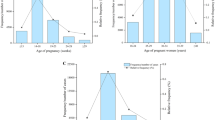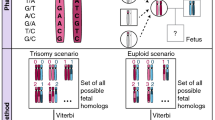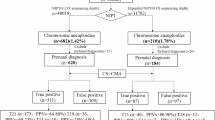Abstract
The purpose of this noninvasive prenatal testing (NIPT) study was to compare the fetal fraction of singleton gestations by gestational age, maternal characteristics and chromosome-specific aneuploidies as indicated by z-scores. This study was a multicenter prospective cohort study. Test data were collected from women who underwent NIPT by the massively parallel sequencing method. We used sequencing-based fetal fraction calculations in which we estimated fetal DNA fraction by simply counting the number of reads aligned within specific autosomal regions and applying a weighting scheme derived from a multivariate model. Relationships between fetal fractions and gestational age, maternal weight and height, and z-scores for chromosomes 21, 18 and 13 were assessed. A total of 7740 pregnant women enrolled in the study, of which 6993 met the study criteria. As expected, fetal fraction was inversely correlated with maternal weight (P<0.001). The median fetal fraction of samples with euploid result (n=6850) and trisomy 21 (n=70) were 13.7% and 13.6%, respectively. In contrast, the median fetal fraction values for samples with trisomies 18 (n=35) and 13 (n=9) were 11.0% and 8.0%, respectively. The fetal fraction of samples with trisomy 21 NIPT result is comparable to that of samples with euploid result. However, the fetal fractions of samples with trisomies 13 and 18 are significantly lower compared with that of euploid result. We conclude that it may make detecting these two trisomies more challenging.
Similar content being viewed by others
Log in or create a free account to read this content
Gain free access to this article, as well as selected content from this journal and more on nature.com
or
References
Chitty, L. S. & Bianchi, D. W. Noninvasive prenatal testing: the paradigm is shifting rapidly. Prenat. Diagn. 33, 511–513 (2013).
Palomaki, G. E., Deciu, C., Kloza, E. M., Lambert-Messerlian, G. M., Haddow, J. E., Neveux, L. M. et al. DNA sequencing of maternal plasma reliably identifies trisomy 18 and trisomy 13 as well as Down syndrome: an international collaborative study. Genet. Med. 14, 296–305 (2012).
Bianchi, D. W., Platt, L. D., Goldberg, J. D., Abuhamad, A. Z., Sehnert, A. J. & Rava, R. P. Genome-wide fetal aneuploidy detection by maternal plasma DNA sequencing. Maternal blood is source to accurately diagnose fetal aneuploidy (MELISSA) Study Group. Obstet. Gynecol. 119, 890–901 (2012).
Porreco, R. P., Garite, T. J., Maurel, K., Marusiak, B ., Obstetrix Collaborative Research Network, Ehrich, M. et al. Noninvasive prenatal screening for fetal trisomies 21, 18, 13 and the common sex chromosome aneuploidies from maternal blood using massively parallel genomic sequencing of DNA. Am. J. Obstet. Gynecol. 211, 365. e1–e12 (2014).
Norton, M. E., Jacobsson, B., Swamy, G. K., Laurent, L. C., Ranzini, A. C., Brar, H. et al. Cell-free DNA analysis for noninvasive examination of trisomy. N. Engl. J. Med. 372, 1589–1597 (2015).
Sago, H. & Sekizawa, A.,, Japan NIPT Consortium Nationwide demonstration project of next-generation sequencing of cell-free DNA in maternal plasma in Japan: 1-year experience. Prenat. Diagn. 35, 1–6 (2015).
Suzumori, N., Ebara, T., Kumagai, K., Goto, S., Yamada, Y., Kamijima, M. et al. Non-specific psychological distress in women undergoing noninvasive prenatal testing because of advanced maternal age. Prenat. Diagn. 34, 1055–1060 (2014).
Bianchi, D. W. & Wilkins-Haug, L. Integration of noninvasive DNA testing for aneuploidy into prenatal care: What has happened since the rubber met the road? Clin. Chem. 60, 78–87 (2014).
Taglauer, E. S., Wilkins-Haug, L. & Bianchi, D. W. Review: cell-free fetal DNA in the maternal circulation as an indication of placental health and disease. Placenta 28, S64–S68 (2014).
Hahn, S. & Huppertz, W. Fetal cells and cell free fetal nucleic acids in maternal blood: new tools to study abnormal placentation? Placenta 26, 515–526 (2005).
Hudecova, I., Sahota, D., Heung, M. M., Jin, Y., Lee, W. S., Leung, T. Y. et al. Maternal plasma fetal DNA fractions in pregnancies with low and high risks for fetal chromosomal aneuploidies. PLoS ONE 9, e88484 (2014).
Kim, S. K., Hannum, G., Geis, J., Tynan, J., Hogg, G., Zhao, C. et al. Determination of fetal DNA fraction from the plasma of pregnant women using sequence read counts. Prenat. Diagn. 35, 810–815 (2015).
Ashoor, G., Syngelaki, A., Poon, L. C. Y., Rezende, J. C. & Nicolaides, K. H. Fetal fraction in maternal plasma cell-free DNA at 11–13 weeks’ gestation: relation to maternal and fetal characteristics. Ultrasound Obstet. Gynecol. 41, 26–32 (2013).
R Development Core Team R: A Language and Environment for Statistical Computing, (R Foundation for Statistical Computing, Vienna, Austria, 2005); ISBN 3-900051-07-0; available at: http://www.R-project.org Accessed 26 February 2015.
Kanda, Y. Investigation of the freely-available easy-to-use software ‘EZR’ (Easy R) for medical statistics. Bone Marrow Transplant. 48, 452–458 (2013).
Fox, J. The R Commander: a basic-statistics graphical user interface to R. J. Stat. Softw. 19, 1–42 (2005).
Rava, R. P., Srinvasan, A., Sehnert, A. J. & Bianchi, D. W. Circulating fetal cell-free DNA fractions differ in autosomal aneuploidies and monosomy X. Clin. Chem. 60, 243–250 (2014).
Shi, X., Zhang, Z., Cram, D. S. & Liu, C. Feasibility of noninvasive prenatal testing for common fetal aneuploidies in an early gestational window. Clin. Chim. Acta 439, 24–28 (2015).
Brar, H., Wang, E., Struble, C., Musci, T. & Norton, M. E. The fetal fraction of cell-free DNA in maternal plasma is not affected by a prior risk of fetal trisomy. J. Matern. Fetal Neonatal Med. 26, 143–145 (2013).
Liu, Y. Y., Chik, K. W., Chiu, R. W., Ho, C. Y. & Lo, Y. M. Predominant hematopoietic origin of cell-free DNA in plasma and serum after sex-mismatched bone marrow transplantation. Clin. Chem. 48, 421–427 (2002).
Haghiac, M., Vora, N. L., Basu, S., Johnson, K. L., Presley, L., Bianchi, D. W. et al. Increased death of adipose cells, a path to release cell free DNA into systemic circulation of obese women. Obesity 20, 2213–2219 (2012).
Nicolaides, K. H. Turning the pyramid of prenatal care. Fetal Diagn. Ther. 29, 183–196 (2011).
Acknowledgements
This study was supported by Sequenom Inc. We thank all the members of the Japan NIPT consortium for their thoughtful cooperation on this project. We also thank Mr Susumu Ono, Makoto Inaki and Shunsuke Miyai at GeneTech (Tokyo, Japan) for their help with the data sample analysis. This report was supported by the Grant of National Center for Child Health and Development 24-3, Japan.
Author information
Authors and Affiliations
Consortia
Corresponding author
Ethics declarations
Competing interests
The authors declare no conflict of interest.
Additional information
Members of the Japan NIPT Consortium Toshiaki Endo1, Akimune Hukushima2, Satoshi Nanba3, Hisao Osada4, Yasuyo Kasai5, Atsushi Watanabe6, Yukiko Katagiri7, Naoki Takesita7, Masaki Ogawa8, Takashi Okai9, Shun-ichiro Izumi10, Haruka Hamanoue11, Kazufumi Haino12, Naoki Hamajima13, Haruki Nishizawa14, Yoko Okamoto15, Hiroaki Nakamura16, Takeshi Kanekawa17, Jun Yoshimatsu18, Shinya Tairaku19, Katsuhiko Naruse20, Hisashi Masuyama21, Maki Hyodo22, Takashi Kaji23, Kazutoshi Maeda24, Keiichi Matsubara25, Masanobu Ogawa26, Toshiyuki Yoshizato27, Takashi Ohba28, Yukie Kawano29 1Department of Obstetrics and Gynecology, Sapporo Medical University School of Medicine, Japan; 2Departments of Obstetrics and Gynecology, Iwate Medical University School of Medicine, Japan; 3Departments of Obstetrics and Gynecology, Saitama Medical University School of Medicine, Japan; 4Department of Obstetrics and Gynecology, Chiba University Graduate School of Medicine, Japan, 5Department of Obstetrics and Gynecology, Japanese Red Cross Medical Center, Japan; 6Division of Clinical Genetics, Nippon Medical School Hospital, Japan; 7Department of Obstetrics and Gynecology, Toho University Omori Medical Center, Japan; 8Perinatal Medical Center, Tokyo Women’s Medical University Hospital, Japan; 9Maternal and Child Health Center, Aiiku Hospital, Tokyo, Japan; 10Department of Obstetrics and Gynecology, Tokai University School of Medicine, Japan; 11Department of Human Genetics, Yokohama City University Graduate School of Medicine, Japan; 12Department of Obstetrics and Gynecology, Niigata University Medical and Dental Hospital, Japan; 13Department of Pediatrics, Nagoya City West Medical Center, Japan; 14Department of Obstetrics and Gynecology, Fujita Health University, Japan; 15Department of Obstetrics, Osaka Medical Center and Research Institute for Maternal and Child Health, Japan; 16Department of Obstetrics, Osaka City General Hospital, Japan; 17Department of Obstetrics and Gynecology, Osaka University Faculty of Medicine, Japan; 18Department of Perinatology and Gynecology, National Cerebral and Cardiovascular Center, Japan; 19Department of Obstetrics and Gynecology, Kobe University Graduate School of Medicine, Japan; 20Department of Obstetrics and Gynecology, Nara Medical University, Japan; 21Okayama University Graduate School of Medicine, Japan; 22Hiroshima University Graduate School of Medicine, Japan; 23The University of Tokushima Faculty of Medicine, Japan; 24Department of Obstetrics and Gynecology, Shikoku Medical Center for Children and Adults, Japan; 25Department of Obstetrics and Gynecology, Ehime University School of Medicine, Japan; 26Department of Obstetrics and Gynecology, Clinical Research Institute, National Hospital Organization Kyushu Medical Center, Japan; 27Center for Maternal, Fetal and Neonatal Medicine, Fukuoka Univerisity Hospital, Japan; 28Department of Obstetrics and Gynecology, Kumamoto University, Kumamoto, Japan; 29Department of Molecular Pathology, Faculty of Medicine, Oita University, Japan
Rights and permissions
About this article
Cite this article
Suzumori, N., Ebara, T., Yamada, T. et al. Fetal cell-free DNA fraction in maternal plasma is affected by fetal trisomy. J Hum Genet 61, 647–652 (2016). https://doi.org/10.1038/jhg.2016.25
Received:
Revised:
Accepted:
Published:
Issue date:
DOI: https://doi.org/10.1038/jhg.2016.25
This article is cited by
-
Association between cell-free DNA fetal fraction and pregnant character: a retrospective cohort study of 27,793 maternal plasmas
Scientific Reports (2023)
-
Chromosomal phase improves aneuploidy detection in non-invasive prenatal testing at low fetal DNA fractions
Scientific Reports (2022)
-
Fetal fraction evaluation in non-invasive prenatal screening (NIPS)
European Journal of Human Genetics (2019)
-
The Effect of Freezing on Non-invasive Prenatal Testing
Scientific Reports (2019)
-
The Significance of Test Failures in Noninvasive Prenatal Screening for Fetal Aneuploidy Using Cell-free DNA
Journal of Fetal Medicine (2017)



